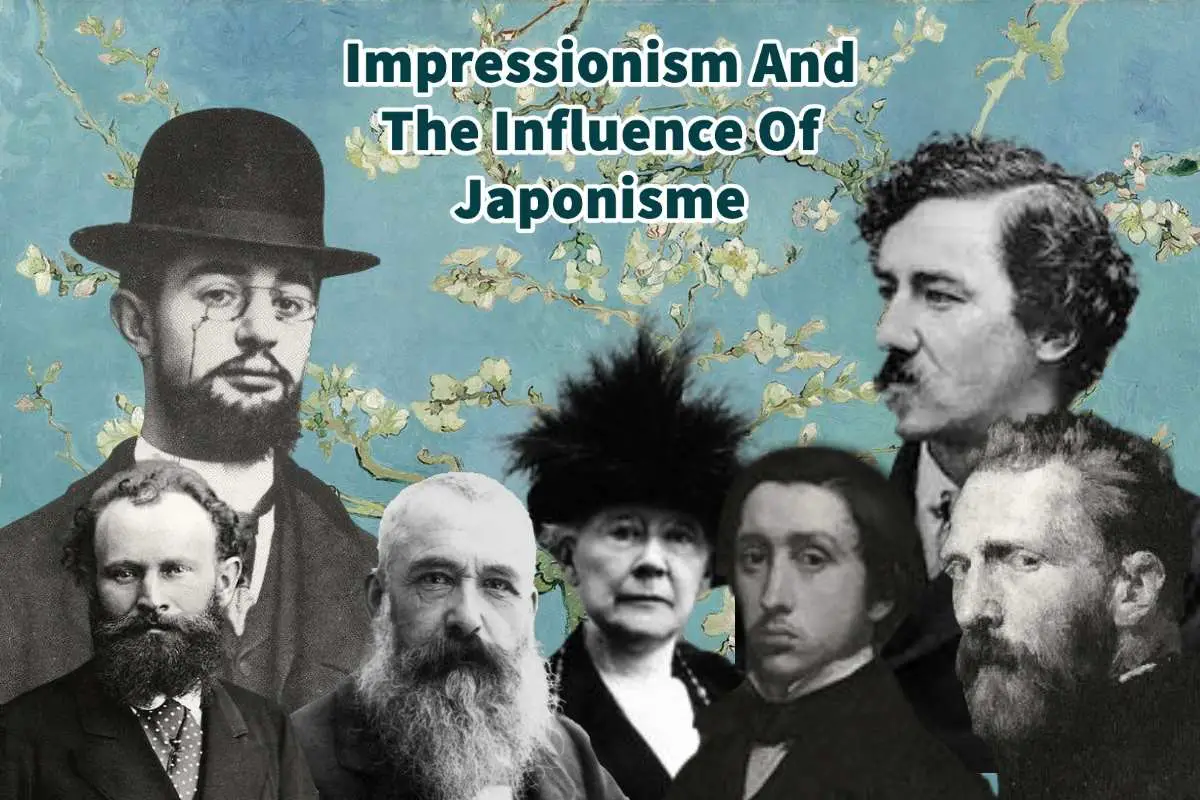Impressionism is considered the first modern art movement. Even today, Impressionism remains the most famous art movement that people study,
The word Japonisme was used to describe the influence of Japanese art on Impressionism art. The Impressionism artists would study Japanese art and then incorporate parts of the Japanese art techniques and inspiration into their art. Japanese art influenced artists like Claude Monet, Vincent Van Gogh, Edouard Manet, Mary Cassatt, Edgar Degas, Paul Gauguin, James McNeill Whistler, and Henri de Toulouse-Lautrec.
Table of Contents
- Influence Of Japonisme On Immpressionsim Art
- Major Impressionism Artists That Japonisme Influenced
- Claude Monet – La Japonaise (1876)
- Vincent Van Gogh – Almond Blossoms (1890)
- Eduoard Manet – Cats (1868-69)
- Mary Cassatt – The Bango Lessons (1893)
- Edgar Degas – Woman Combing Her Hair (1888-90)
- Paul Gauguin – Two Tahitian Women (1899)
- James McNeill Whistler – Caprice In Purple And Gold: The Golden Screen (1864)
- Henri de Toulouse – Lautrec – May Belford (1895)
- Frequently Asked Questions
- Related Questions
Influence Of Japonisme On Immpressionsim Art
The word Japonisme was coined by the French art critic Philippe Burty in 1872. The term Japonisme referred to the trend of using aspects of Japanese art and the influence of Japanese art on western art and artists, particularly among many European artists.
Japan opened for trade in 1853; this was the first time in 200 years that Japan was open to the western world, and Japan began trading with the west. With this new trade era, Japanese art, fabrics, and even culture came into the western world, including Europe.
The word Japonisme is a word that is mainly used to describe the influence of Japanese art on European art. Japanese art influenced many art movements, including Art Nouveau, Impressionism, and Post Impressionism. The term Japonisme was coined to describe the Japanese art and design craze in Europe.
The rediscovery of Japanese art had a significant effect on Western art. Japanese art profoundly affected the development of modern paintings from Impressionism, including Impressionism’s art of flatness, color choices, and stylization. The most notable Japanese influence was the Ukiyo-e Japanese woodblock prints’ influence on Impressionism art.
Major Impressionism Artists That Japonisme Influenced
Some of the significant Impressionism and Post Impressionism artists influenced by Japanese art include Claude Monet, Vincent Van Gogh, Edouard Manet, Mary Cassatt, Edgar Degas, Paul Gauguin, James McNeill Whistler, and Henri de Toulouse-Lautrecto – to name a few. The truth is that many artists were influenced by Japanese art during this time.
These artists’ interest in Japanese art was not a passing interest, but some much deeper influences went into their paintings, art, and subject matter.
Here are some significant artists influenced by Japonisme or Japanese art and culture and how Japanese art influenced them:
Claude Monet – La Japonaise (1876)

Usually, when we think of Japonisme and Impressionism artists, we think of Claude Monet. Monet created a garden at his home in Giverny with distinct Japanese influences.
La Japonaise (1876) is an oil painting by Monet of his wife Camilla Doucieux dressed up in a Japanese Kimono and holding a Japanese fan; she is standing in front of a room filled with Japanese fans.
The exciting part of this painting is her pose, the Japanese clothes, and fans all show Japanese influence. Camilla also has on a blonde wig. Camilla was known to have naturally dark hair, but she wore a blonde wig for this painting to symbolize that it was not a 100% Japanese painting but that the west and Japan were being merged in art.
Vincent Van Gogh – Almond Blossoms (1890)

Vincent Van Gogh was an admirer of Japanese art. He was known to have Japanese art pined up all around his art studio. As Vincent Van Gogh said about Japan and Japanese art:
”see with a more Japanese eye”
Vincent Van Gogh
Van Gogh even stated that all his work was based on Japanese art.
One of Van Gogh’s paintings that I feel shows the Japanese feeling the best is the painting entitled Almond Blossoms (1890). The painting shows Almond Blossoms with a blue background beautifully executed with a Japanese style and feel.
The painting was a gift to his brother Theo and sister-in-law for their new baby boy Vincent Willem.
Eduoard Manet – Cats (1868-69)
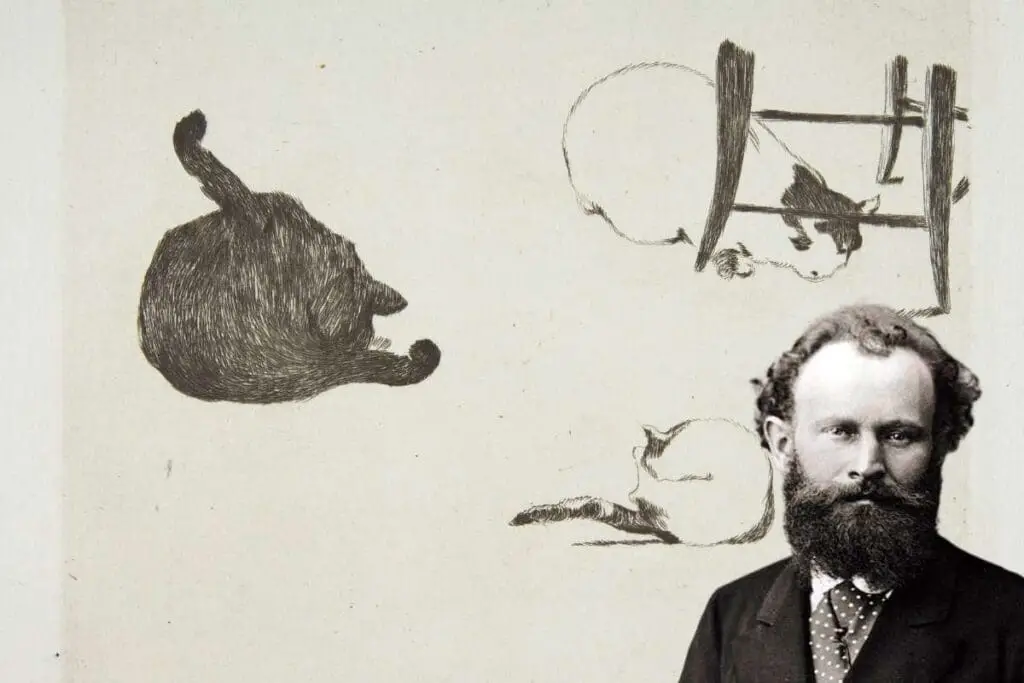
Eduoard Manet is also known to have been influenced by Japanese artists. Manet started to gather and collect a lot of Japanese paintings and woodblock prints.
Besides enjoying these prints, he also started to use the style shown in these prints and paintings by adopting the style of Japanese art and artists.
One of his artwork that clearly shows this is his etching on blue laid paper called Cats (1868-69). The influence of Hokusai’s Cats Woodblock print (1815-1865) can be seen in this painting. In 1815 Hokusai started to make Manga, a Japanese-style comic book that consisted of sketches of everyday people and objects. One of the subjects Hokusai painted was cats.
Mary Cassatt – The Bango Lessons (1893)
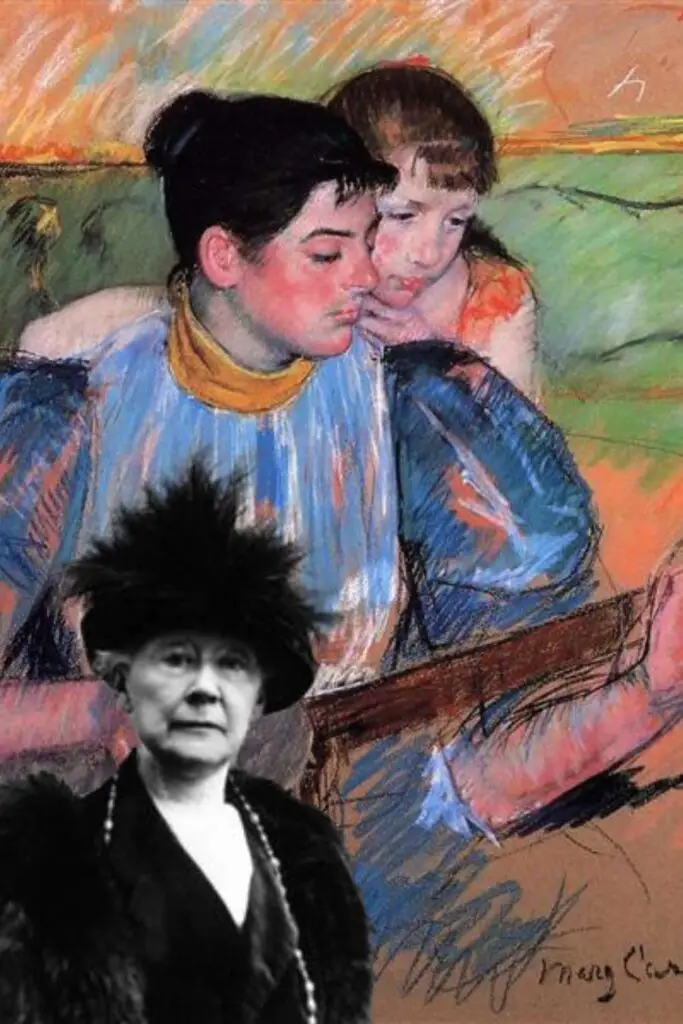
Mary Cassatt was an American Impressionist artist known for depicting women and children in her art. In April 1890, she visited Paris. She attended an exhibition that had a lot of Japanese Ukiyo-e woodblock prints.
She was so inspired by what she said the Japanese were doing and their techniques that she started to use aquatint, drypoint, etching, and hand-coloring. She attempted to capture many of the woodblock prints’ flat planes and simple lines.
Mary Cassatt’s The Bango Lesson (1893) is a color drypoint and aquatint with monotype inking. In this print, you can see the influence of the Japanese with the colors, composition, and simple lines.
Edgar Degas – Woman Combing Her Hair (1888-90)
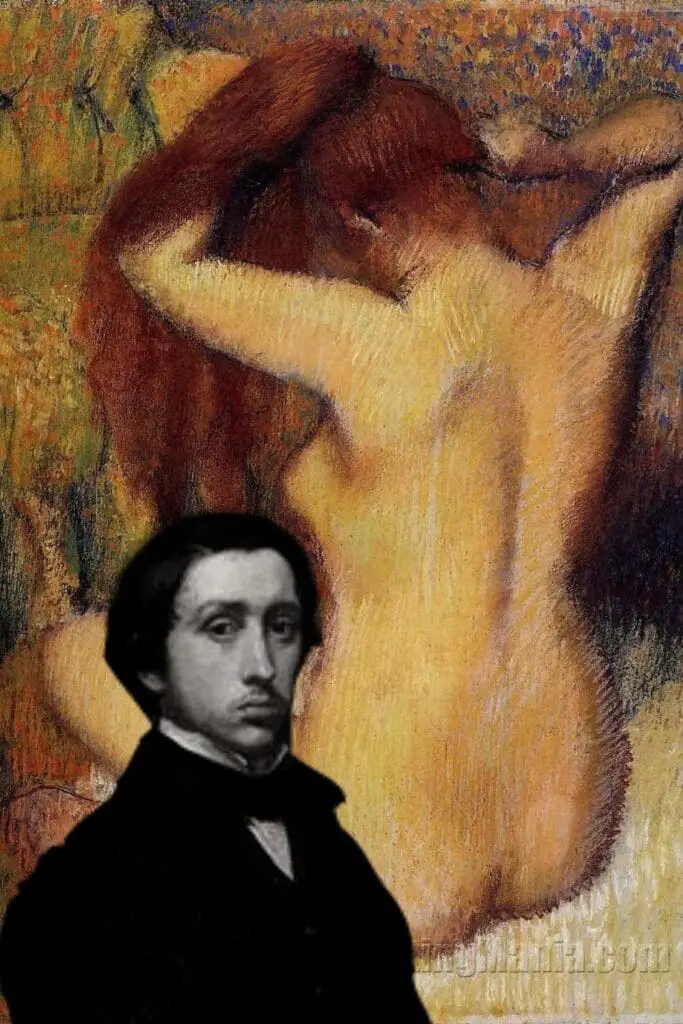
Edgar Degas found a lot of influence from Japanese sketches and art. He was inspired by their linear perspective, asymmetrical compositions, and aerial views.
We can see the Japanese influence in Degas’s art as he also used a lot of candid and everyday scenes from life in France, including some intimate moments.
In Degas’s painting of Woman Combing her Hair (1888-1890), Degas shows a woman with her backed turned to us, completely naked, combing her hair. He is sharing this real-life and intimate yet private moment of a woman combing through her hair.
Another Japanese artist also painted a similar scene. Utagawa Hiroshige made a woodblock entitled Yamauba Combing her Hair and Kintoki (1801). The Japanese version of combing the hair has some composition and content similarities to Degas’s painting.

Paul Gauguin – Two Tahitian Women (1899)
Vincent Van Gogh and Paul Gauguin shared a house for a while in Southern France. They also shared the love of Japanese art and artists.
Many believe that Van Gogh Introduced Gauguin to Japanese art as Van Gogh was known to have an extensive collection of Japanese art prints. Many of Gauguin’s paintings show influences from Japanese woodblock prints.
During his time in Tahiti, Gauguin’s art displayed the characteristics of so many woodblock prints from the Japanese Ukiyo-e era – laziness, sexual pleasures, and available women.
One of his more famous paintings is Two Tahitian Women (1899). The picture shows two topless Tahitian women holding mango blossoms.
James McNeill Whistler – Caprice In Purple And Gold: The Golden Screen (1864)
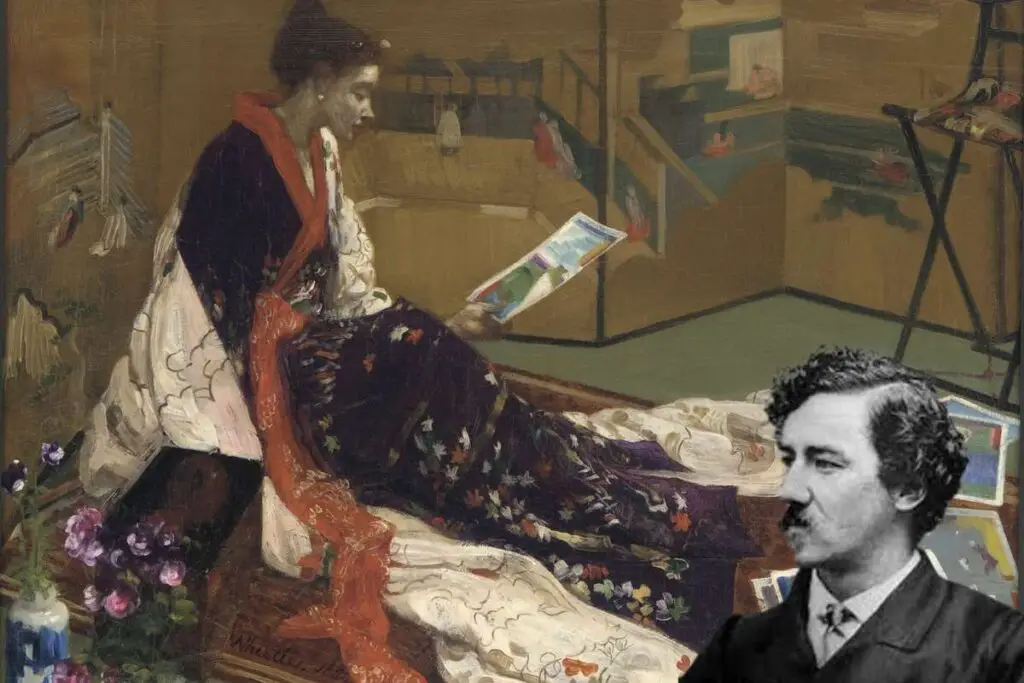
Asain influences profoundly influenced the American Artist James McNeill Whistler. Though part of the American Glided age-based primarily in the United Kingdom, he was greatly influenced by Japanese art and paved the way for other artists to follow.
His painting Caprice in Purple and Gold: The Golden Screen (1864) was a great example of the Japanese influence on art. In this painting, Whistler changed the course of art with his radical techniques and subject matter.
The painting shows his adoption of Asian design principles and emphasizes dimensional flattening; the way he arranged abstract patterns is very Asian.
Henri de Toulouse – Lautrec – May Belford (1895)
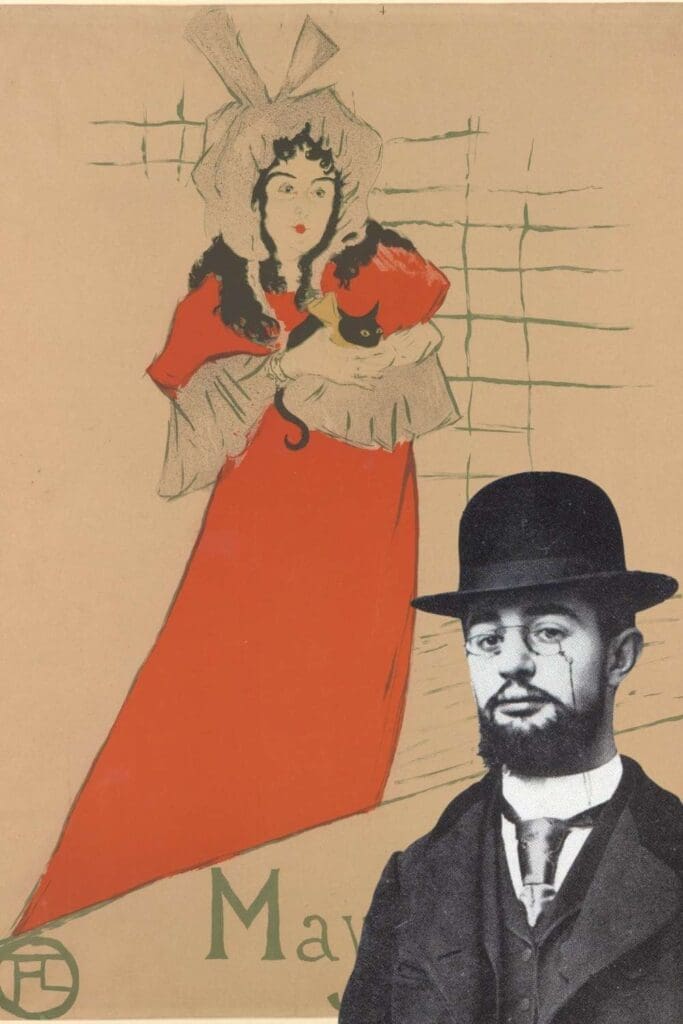
Henri de Toulouse was a French painter, printmaker, draughtsman, caricaturist, and illustrator. Japanese art also influenced him.
One of my favorite works that Toulouse – Lautrec did that also show his Japanese influences is the lithograph of May Belford (1895). May Belford was an Irish singer who made a name for herself on the stages of Parisian nightclubs with her songs and her ever-present black cat.
In this poster that Toulouse-Lautrec did, May almost has a feeling of being Japanese, even though she was Irish. You can see the influences from the Japanese woodblock print artists in how simple this poster is while at the same time how May is standing.
Japanese art had a considerable influence on Impressionism artists. Everything from how the art was completed to the subject matter to the choice of colors and techniques. So many of these artists became profound collectors of Japanese art and great fans of Japanese culture.
Frequently Asked Questions
What is Impressionism, and why is it considered the first modern art movement?
Impressionism emerged in the late 19th century and is recognized as the first modern art movement due to its departure from traditional artistic conventions. Artists sought to capture the fleeting effects of light and color in their works, often opting for outdoor scenes and rapid brushstrokes.
How did Japanese art influence the Impressionist movement?
Japonisme refers to the impact of Japanese art on Impressionism. Impressionist artists, including Monet, Van Gogh, and Manet, were inspired by Japanese woodblock prints, adopting elements like flattened perspectives, bold colors, and asymmetry in their own works.
Which Impressionist artists were particularly influenced by Japonisme?
Claude Monet, Vincent Van Gogh, Edouard Manet, Mary Cassatt, Edgar Degas, Paul Gauguin, James McNeill Whistler, and Henri de Toulouse-Lautrec are among the Impressionist artists who were significantly influenced by Japanese art.
How did Japonisme manifest in the works of Impressionist artists like Claude Monet?
Claude Monet incorporated Japanese-inspired elements in his paintings, such as using Asian motifs in his garden scenes, embracing asymmetrical compositions, and employing the Japanese concept of “ukiyo-e” (pictures of the floating world) in his depiction of nature.
In what ways did Japonisme impact the color palette of Impressionist art?
Japonisme influenced the Impressionists’ use of color, encouraging the adoption of vibrant and unconventional color schemes. The bold and expressive use of color in Japanese prints inspired Impressionist artists to experiment with new and vibrant palettes.
How did the Impressionists reinterpret Japanese techniques in their art?
Impressionists borrowed techniques from Japanese art, such as the emphasis on capturing the essence of a scene rather than intricate details, the use of unconventional perspectives, and a focus on everyday life. These elements contributed to the distinctive style of Impressionist paintings.
Did the influence of Japonisme extend beyond painting in the Impressionist era?
Yes, the influence of Japonisme extended beyond painting to various art forms, including printmaking, decorative arts, and even fashion. The fascination with Japanese aesthetics permeated different aspects of cultural expression during the Impressionist era.
How did the incorporation of Japonisme contribute to the evolution of Impressionist subject matter?
Japonisme played a key role in diversifying Impressionist subject matter. Artists began to explore new themes inspired by Japanese art, such as scenes of leisure, nature, and everyday life, deviating from more traditional Western subject matter.
Were there any specific Japanese art forms that had a profound impact on Impressionist artists?
Japanese woodblock prints, known as ukiyo-e, were particularly influential on Impressionist artists. The distinctive style of these prints, characterized by bold lines, flat colors, and a focus on nature and everyday life, left a lasting impression on the Impressionist movement.
How does the legacy of Japonisme continue to influence the appreciation of Impressionist art today?
The legacy of Japonisme is evident in the continued appreciation and study of Impressionist art. The fusion of Eastern and Western artistic elements has contributed to the enduring appeal of Impressionist works, influencing subsequent generations of artists and captivating art enthusiasts worldwide.
Anita Louise Art is dedicated to art education, great artists, and inspiring others to find and create their art. We love art that uplifts and inspires. #ArtToMakeYouSmile! #ArtToMakeYouHappy!
If you are interested to see any of my art, you can find out more by clicking here. If you are interested in what inspires me and my paintings, you can discover more by clicking here.
We have a free newsletter and would love you to be part of our community; you can subscribe to the newsletter by clicking here. If you have any questions, I would be happy to talk to you at any time. You can reach me, Anita, by clicking here.
Subscribe to our Anita Louise Art YouTube Channel filled with great videos and information by clicking here.
Related Questions
Why Was Impressionism Art At First Rejected?
During the emergence of impressionism art, fine-art oil painting was an essential addition to the interior design, especially for the affluent and the increasing arrival of the middle classes. For these art patrons, only some particular art styles were considered acceptable for them to use for the interior design of their home, and impressionism art did not fit into any of these culturally acceptable fine art categories.
By clicking here, you can learn more by reading Why Was Impressionism Art at First Rejected?
Similarities of Expressionism And Impressionism Art And Their Differences
Impressionism and Expressionism art movements started in Europe, but the impressionism movement started before the Expression art movement. Each movement has different looks of art which are distinguishable from each other. Even though they are both different art movements, there are still some similarities between them.
By clicking here, you can learn more by reading Similarities of Expressionism and Impressionism Art And Their Differences
What Does Japonisme Mean?
The term Japonisme is about the influence of Japanese art on European culture and arts. Most notably, the influence Japanese woodblock prints had on the Impression art movement. Many of the prominent artists from the Impressionism art movement were inspired by the Japanese Ukiyo-e woodblock print artists.
By clicking here, you can learn more by reading What Does Japonisme Mean?.

